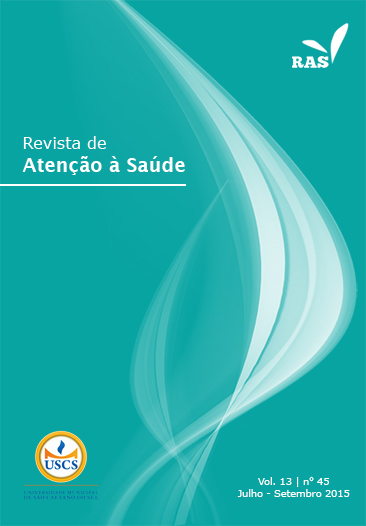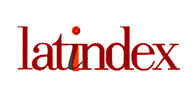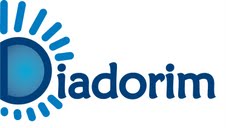DIETARY INTAKE OF IRON AND CALCIUM FOR ADOLESCENTS ON REPRODUCTIVE PHASE OF A PUBLIC SCHOOL OF PETROLINA – PERNAMBUCO
DOI:
https://doi.org/10.13037/ras.vol13n45.2814Keywords:
Adolescence, reproductive phase, food intake, iron and calcium.Abstract
Objective: To estimate the dietary intake of iron and calcium by adolescents in the reproductive phase in apublic school of Petrolina, Pernambuco. Methods: 274 female adolescents, aged between 11 and 17 yearsold, were interviewed. The dietary intake survey was conducted through 24-hour recall (R24h). To calculateiron and calcium intake in the adolescent population, we used as reference the Dietary Reference intakes/Reference Daily Intake - Recommended Dietary Allowances/Dietary Intake Recommended and AdequateIntake/Intake and Adequate. The data were described as means and standard deviations, verifying therelation between the variables: age and nutrient intake. We used the softwares Excel (2013 Version) andGraph Prism (6.01 Version) for statistical treatment of the data. Results: We could verify that the averageiron intake was higher than the recommended in 81 (29.54%) adolescents, while 193 (70.04%) didnot achieve the recommended amount. Regarding the calcium intake, only 47 (17.15%) demonstratedadequate intake. Among the iron-rich plant-based foods, the consumption of beans (83.2%) stood out.Meat (61.31%) and eggs (19.7%) were the foods of animal origin consumed the most. The food sources ofcalcium with the highest intakes were: whole milk (63.1%), cheese (43.8%), yogurt (27.74%), ice cream(14.6%) and cottage cheese (5.1%), respectively. Conclusions: This study found insufficient intake ofmicronutrients evaluated in most adolescents, highlighting the need for an intervention in order to repairthis deficiency.Downloads
References
1. Azevedo L, Martino HSD, Carvalho FG, Rezende ML. Estimativa da ingestão de ferro e vitamina C em adolescentes no ciclo menstrual. Ci & Saúde Col. 2010;15(Supl.1):1359-67.
2. Davim RMB, Germano RM, Menezes RMV, Carlos DJD. Adolescente/adolescência: revisão teórica sobre uma fase crítica da vida. Rev Rene. 2009;10(n.2):131-40.
3. Mota DCL, Laus MF, Almeida SS, Costa TMB, Moreira RCM. Imagem corporal e suas relações com a atividade física e o estado nutricional em adolescentes. Psico. 2012;43(n.2):237-42.
4. Beinner MA, Moraisa EAH, Filho JDL, Jansena AK, Oliveira SR, Reis IA, Reis E, et al. Fatores associados à anemia em adolescentes escolares do sexo feminino. Rev Baiana de Saúde Pública. 2013;37(n.2):439-51.
5. Unilever Health Institute [Internet]. Brasil: [citado em 28 de Maio de 2012]. Disponível em: http://www.unileverhealthinstitute.com.br/artigo/adolescentes-e-os-micronutrientes. [acesso em 8 maio 2014].
6. Vasconcelos PN, Santos TMP, Vasconcelos SML. Consumo de ferro e anemia em mulheres hipertensas e/ou diabéticas. Rev Bras Cardiol. 2013;26(1):17-25.
7. Oliveira CF. Consumo de cálcio por adolescentes de escolas públicas (estaduais e municipais) e privadas do município
de Chapecó-SC [dissertação]. Porto Alegre: Universidade Federal do Rio Grande do Sul; 2012.
8. Rodrigues AM, Cintra IP, Santos LC, Martini LA, Mello MT, Fisberg M. Densidade mineral óssea, composição corporal e ingestão alimentar de adolescentes modelos de passarela. J Pediatr. 2009;85(n.6):503-8.
9. Pierry C, Mosca LN, Schena C, Santos LC. Consumo alimentar, ingestão de cálcio e antropometria de adolescentes de escola municipal e particular do município de Santos, SP. Pediatria. 2010;32(3):197-203.
10. Bueno AL, Czepielewski MA. O recordatório de 24 horas como instrumento na avaliação do consumo alimentar de cálcio, fósforo e vitamina D em crianças e adolescentes de baixa estatura. Rev Nutr. 2010;23(1):65-73.
11. Zaboto CB, Viana RPT, Gil MF, Cunha DTO, Moreira MA, Domene SAM, et al. Registro fotográfico para inquéritos dietéticos: utensílios e porções. Goiânia: UFG; 1996.
12. Tabela brasileira de composição de alimentos / NEPA – UNICAMP. – 4ª ed. rev. e ampl.-Campinas: NEPAUNICAMP, 2011. 161 p.
13. Pinheiro ABV, Lacerda EMA, Benzecry EH, Gomes MCS, Costa VM. Tabela para avaliação do consumo alimentar em
medidas caseiras. 4ª ed. São Paulo: Atheneu; 2005.
14. Luna RCP, Pereira MC, Santos JB, Coutinho ISL, Gonçalves MCR, Oliveira R. Consumo alimentar habitual de cálcio e sódio e sua relação com indicadores antropométricos em mulheres adultas. Rev Bras Cien Saúde. 2011;15(2):201-8.
15. Garanito MP, Pitta TS, Carneiro JDA. Deficiência de ferro na adolescência. Rev Bras Hematol. Hemoter. 2010;32(Supl.2):45-8.
16. Santos CLA, Akerman M, Faccenda O, Martins LC, Reato LFN. Deficiência de ferro no estirão. J Hum Growth Dev. 2012;22(3):341-7.
17. Cançado RD. Deficiência de ferro: causas, efeito e tratamento. Disponível em: http://www.moreirajr.com.br/revistas.asp?id_materia=4036&fase=imprime. [acesso em 11 jun.2014].
18. Rodrigues LP, Jorge SRPF. Deficiência de ferro na mulher adulta. Rev Bras Hematol. Hemoter. 2010;32(Supl.2):49-52.
19. Sato APS, Fujimori E, Szarfarc SC, Borges ALV, Tsunechiro MA. Consumo alimentar e ingestão de ferro de gestantes e mulheres em idade reprodutiva. Rev Latino-Am Enfermagem. 2010;18(2):[nove telas].
20. Brigide P, Ataíde TR, Baptista AS, Abdalla AL, CanniattiBrazaca SG, Silva TS, et al. Métodos de determinação da biodisponibilidade do ferro: ênfase na utilização de radionuclídeo 59Fe. Nutrire: rev. Soc. Bras. Alim. Nutr. 2011;36(n.3):93-107.
21. Candeias AMPPTR. Deficiência em ferro e frequência alimentar em crianças em idade escolar na Ilha de Santa Maria [dissertação]. Lisboa: Universidade Católica Portuguesa; 2012.
22. Esteves EA, Rodrigues CAA, Paulino EJ. Ingestão dietética de cálcio e adiposidade em mulheres adultas. Rev Nutr. 2010;23:543-52.
23. Pereira GAP, Genaro PS, Pinheiro MM, Szejnfeld VL, Martini LA. Cálcio dietético – estratégias para otimizar o consumo. Rev Bras Reumatol. 2009;49(2):164-80.
24. Bertin RL, Karkle ENL, Ulbrich AZ, Neto AS, Bozza R, Araujo IQ, Campos W. Estado nutricional e consumo alimentar de adolescentes da rede pública de ensino da cidade de São Mateus do Sul, Paraná, Brasil. Rev Bras Saúde Matern. Infant. 2008;8(4):435-43.
25. Brasil. Brasileiros de todas as faixas etárias consomem pouco cálcio e muito sódio [Internet]. Brasil: Instituto Brasileiro de Estatística e Geografia Econômica – IBGE: [citado em 28 julho 2011]. Disponível em <http://www.brasil.gov.br/saude/2011/07/brasileiros-de-todas-as-faixas-etariasconsomem-pouco-calcio-e-muito-sodio>. [acesso em 21maio 2014].
26. Barbosa C, Andreazzi M. Intolerância à lactose e suas consequências no metabolismo do cálcio. Rev Saúde e Pesquisa.
2011;4(n.1):81-6.
27. Douglas CR. Funções dos minerais. Fisiologia aplicada à nutrição. Rio de Janeiro: Guanabara Koogan; 2011:105-18.
28. Cozzolino SMF. Biodisponibilidade de nutrientes. 3ª. ed.Barueri, SP: Manole; 2009.
Downloads
Published
Issue
Section
License
Copyright (c) 2015 DARLING SILVA DOS SANTOS FERREIRA, MARINA AMARAL ALMEIDA TORRES, INGRID RAFAELLA MAURICIO SILVA, Cristhiane Maria Bazílio de Omena Messias

This work is licensed under a Creative Commons Attribution-NonCommercial-NoDerivatives 4.0 International License.
Policy Proposal for Journals offering Free Delayed Access
Authors who publish in this magazine agree to the following terms:
- Authors maintain the copyright and grant the journal the right to the first publication, with the work simultaneously licensed under a Creative Commons Attribution License after publication, allowing the sharing of the work with recognition of the authorship of the work and initial publication in this journal.
- Authors are authorized to assume additional contracts separately, for non-exclusive distribution of the version of the work published in this magazine (eg, publishing in institutional repository or as a book chapter), with the acknowledgment of the authorship and initial publication in this journal.
- Authors are allowed and encouraged to publish and distribute their work online (eg in institutional repositories or on their personal page) at any point before or during the editorial process, as this can generate productive changes, as well as increase impact and citation of the published work (See The Effect of Open Access).









